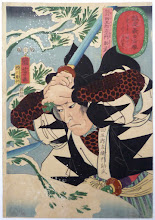I'm slightly drunk, and I just got home and wrote this little bit of text for Flying Swordsmen RPG over the last 10 minutes. It's a rough 1st draft, but I like it. Anything out there anyone thinks I should add?
MAKING COMBAT FUN AND EXCITING
As mentioned above, combats that just follow the numbers, going through the combat round procedure, with rolls to hit and rolls to damage, with the occasional spell or feat thrown in, can get boring fast. And what's the fun of a wuxia book or movie? It's the exciting fight scenes. Here are some tips for both players and for GMs to make the battles that will inevitably ensue more fun and dynamic.
1.Fights that Matter: Early RPGs, and many computer RPGs that were based on those early RPGs, involve lots of random encounters that serve no purpose other than to try to speed play before resources are whittled down by these pointless monster confrontations (or worse, as simple XP feeds so characters can level up). A wuxia themed game is better served by planned encounters that, if they turn into battles (and they need not), become set piece battles. Battles with a goal aside from just beating down the enemy are superior to pointless battles just because the enemy, or the monster, is there.
2.Interesting Locations: Those battles that matter are more fun the more detailed the location for the battle is described. An ancient temple, a warehouse in the middle of the city, a busy market street, a ship on a storm-tossed ocean—these are evocative and easily lend to player and GM creativity. Not every battle needs to take place in an exotic locale, but many should be staged in a way that the environment can—and will—become a factor in the battle.
3.Tear up the Scenery: Just because the GM didn't say it was there doesn't mean you can't, as a player, add it in. The game world is a creation of all of the players, and if you're fighting in a warehouse, go ahead and swing from the pulleys or dance along a scaffolding. Knock over some barrels to block an enemy's advance or break a lantern and start a fire to cover your retreat. Martial arts movies, especially, love to work in anything and everything on the set into the fights, and players and GMs should look for ways to do likewise.
4.The Way of the Ming Vase: If I may paraphrase Matt Finch, if there's a priceless Ming vase in the room where the combat is happening, it's irresponsible for it to NOT become part of the battle. This ties in with the above points in that if there's some reason to be having the fight, and some important object is in the area, the fight had better revolve around it in some way. Players will feel more tied to the outcome of the fight, and the thrill of victory or the agony of defeat (and desire to make a comeback) that much greater for it.
5.There's Always Another Monster: The GM has at his or her disposal an endless supply of mosnters and NPCs with which to challenge the PCs. So don't get tied up with any specific NPCs or monsters. If the PCs manage to defeat them before the GM planned, so what? Think up something new. Let the story lines that emerge come FROM play, and let the battles and non-combat conflicts come from character actions whenever possible. This way, players will feel more a part of the setting, and will have more of a stake in the outcome of the action.
6.Learn to Say Yes (For GMs), and Learn to Try (for players): Players need to feel free to try crazy stuff in the game, and GMs should want to let those crazy things happen. If the GM can't give an instant 'yes' answer to some idea of the players, the GM should allow the players to come up with a stunt or contest that will result in that outcome, and the GM should provide a fair TN for a feat, or allow the contest to proceed. This is fantasy action, not a simulation of the real world. Crazy things can, and should, happen often for the PCs.
Forward into the Past
48 minutes ago






Excellent points all around.
ReplyDelete